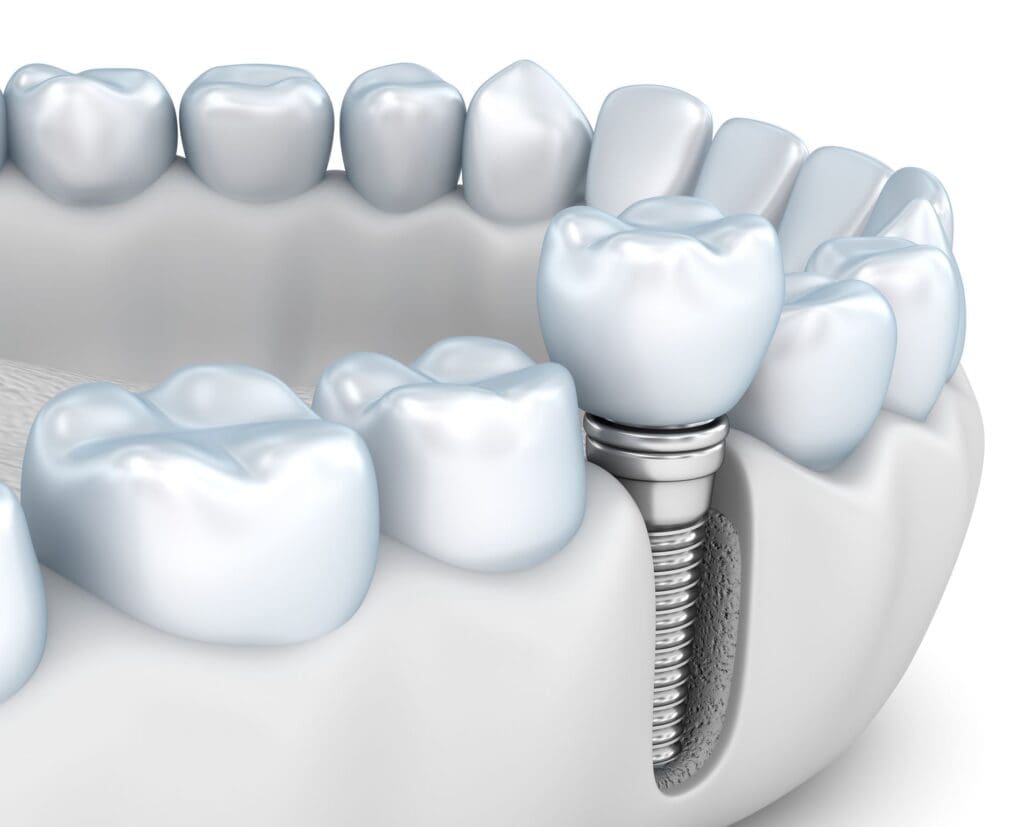If you have lost one or more teeth, you may notice difficulties with your typical oral functions. If you don’t seek treatment from your dentist after tooth loss, you could suffer further issues, like the deterioration of the jawbone.
Replacing missing teeth with dental implants can give you long-lasting restoration for your smile as well as protection for your jaw. Read on to learn more about the health benefits that dental implants can provide for your jawbone if you have missing teeth.

What Happens to the Jaw After Tooth Loss
Patients with optimal dental health have a full set of teeth that include roots that extend below the gumline to reach the jawbone. The roots stimulate the bone in the jaw, keeping it strong.
After a patient loses a tooth, the jaw no longer receives stimulation because the tooth’s root is absent as well. Without the tooth root’s presence, the jawbone will begin to deteriorate. Missing more than one tooth can have an even greater effect on the jawbone’s health.
This can cause the appearance of sagging in the face. It may also impact remaining teeth, causing them to shift out of place and create more dental problems.
Signs Your Jawbone May Be Weakening
After tooth loss, your jawbone begins changing right away, but you might not notice it immediately. Some warning signs include your face looking more sunken or wrinkled than before, especially around the mouth. You might also notice your remaining teeth feeling looser or your dentures not fitting as well as they used to.
Some people experience clicking noises when chewing or talking. If you’ve had missing teeth for a while and notice these changes, talk to your dentist about implants before you lose more bone.
How Do Dental Implants Preserve Jawbone?
A tooth replacement solution that provides prosthetic teeth above the gumline only won’t treat jawbone loss. Though a removable denture can provide some restorative benefits, a dental implant is the best choice for preserving the jawbone after tooth loss.
The dental implant features a titanium post anchor that a dentist surgically places in the jaw. It fuses with the bone there, serving as a replacement for the absent tooth root. The anchor will function as a support for prosthetic teeth attached to it above the gumline.
The anchor’s presence will stimulate the jawbone once again, stopping bone from degenerating. It can also encourage bone that has already been lost to regrow. This will preserve the jaw’s structure and therefore the appearance of the face and teeth.
Can My Jaw Sustain a Dental Implant?
Though dental implants are useful to patients who want to treat bone loss in their jaw, their jaw must still have enough bone to sustain the anchor of an implant. If too much bone is already lost, it won’t be strong enough to support the fusion of the dental implant with the jaw. You might not be a good candidate for this restorative treatment in this instance.
In this case, your dentist may suggest adding more structure to the jawbone with a bone grafting surgery. They may also elect an alternative tooth replacement treatment to restore your smile.
How Bone Grafting Helps Prepare for Implants
If your jawbone has weakened too much, your dentist might recommend bone grafting before getting implants. This procedure adds bone material to your jaw to rebuild its strength. The material can come from another part of your body, a donor, or be synthetic. While it sounds scary, it’s actually a common procedure with a high success rate.
After grafting, it usually takes 3-6 months for the new bone to become strong enough to support an implant. This extra step means you’ll wait longer for your final smile, but it makes implants possible when they otherwise wouldn’t be.
Implants vs. Dentures: Long-Term Jaw Health
While dentures replace teeth above the gums, they don’t stop jawbone loss. In fact, dentures can actually speed up bone loss because they press down on the gums without stimulating the bone underneath. Over years, this causes the jaw to shrink, which is why denture wearers often need adjustments or new dentures.
Implants act like natural tooth roots and maintain the jawbone’s shape and strength. Even implant-supported dentures that attach to a few implants are much better for jaw health than traditional dentures because they provide some bone stimulation.
The Right Time to Get Implants After Tooth Loss
The best time to get implants is within the first year after losing a tooth, before significant bone loss occurs. However, even if you’ve had missing teeth for years, it isn’t necessarily too late. Modern techniques like bone grafting make implants possible for many people who couldn’t get them in the past.
The sooner you talk to your dentist about implants after losing a tooth, the better your options will be. Waiting only makes bone loss worse and treatment more complicated. If you’ve recently lost a tooth or have had gaps for a while, schedule a consultation to explore your options.
Schedule a Visit Today
Our dentists in Claremont, CA, can evaluate your jawbone health with x-ray imaging taken during a dental exam. Schedule a visit online with Claremont Dental Institute to discuss ways to replace your missing teeth and improve your jawbone health today.
